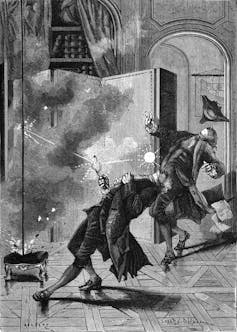
Built in 1913 as a naval radio station, the Shetland Isles’ Met Office at Lerwick provides the temperature reading you see on the top right-hand corner of the UK weather map. The site became part of the Met Office network in 1921 and began regular meteorological and magnetic recording, which continue today – capturing more than a century of atmospheric history.
Experiments with specialised measurements of atmospheric electricity started in 1925, using a clockwork recorder housed in a wooden hut at the edge of the site, with an oil stove to ward off damp. Inauspicious as that small hut near a Loch in Shetland might seem, those and later recordings are among the most important atmospheric electricity measurements made on the planet.
Over the past two decades, with atmospheric science colleagues and students, I have worked with these unique clean air records to unearth fascinating links between Lerwick’s atmospheric electricity and weather patterns across the world. We’re still going through the data – and now we need your help to finally make it fully available to researchers.
In the 1750s the American inventor and statesman Benjamin Franklin inspired widespread (and don’t-try-this-at-home) thunderstorm experiments, following his famous kite experiment to collect static electricity from a cloud.

Soon after, investigators noticed that electricity in the air never quite vanished, even in fine weather. This underlying fair weather electric field was a curiosity, but also, in explaining how it could continue indefinitely, a geophysical puzzle. The 19th-century physicist Lord Kelvin expected that its measurement would provide “…important additions… for prognosticating the weather”. (This suggestion has eventually borne fruit – colleagues and I at the University of Reading recently showed that electricity in the atmosphere can help forecast fog.)
Atmospheric electricity became embedded in the regular work of geomagnetic observatories, included on pioneering atmospheric exploration missions (see The Aeronauts movie) and polar expeditions. Conceptually, the measurements resemble those of a voltmeter, with one test prod placed in the ground and the other in the air. In practice, a rather special voltmeter is needed due to the tiny amounts of electric charge present, and the test probe in the air typically needs a water spray or a radioactive coating to help it collect sufficient charge. At Lerwick, almost continuous measurements were made between January 1927 and July 1984.
From paper to digital
I knew about the Lerwick measurements from the inspirational 1960s Atmospheric Electricity textbook by the Durham scientist Alan Chalmers. In 2002, I chanced on the Observatories Yearbooks in the Radcliffe library in Oxford, and realised this was where that data had been published. Although I was making my own measurements – we started automatic weather recording at Reading in 1997 – the historical data seemed likely to be useful until there was sufficient data from Reading for analysis. But these records have taken on a life of their own.
Transferring the information from paper to digital form was going to be a big task, as there are about half a million hourly entries between 1927 and 1984. Arguing for digitisation was also difficult, as almost no research had been pursued with the data, other than unravelling the effects of nuclear weapons, which later work showed had influenced the weather thousands of miles away. Worse, when the recordings were stopped in the 1980s they were damned as merely “a few specialist measurements”.
Open data approaches were yet to develop, but climate-related sources of any kind were becoming recognised as valuable, so in 2003 the Met Office’s Hadley Centre did arrange image scanning for preservation. Unfortunately, the huge computer data entry problem remained.
The puzzle behind the fair weather electric field was resolved by the Nobel prize winner Charles “CTR” Wilson, who suggested that distant thunderstorms provided an electric current – flowing out to fair weather regions – to sustain it.

Several lines of reasoning now support this, not least from graphing the daily atmospheric electricity variations measured by the Carnegie research ship in the 1920s. The plots showed such similarity in widely different locations that their shape become known as the Carnegie curve. This commonality indicates the fair weather field has a global rather than local origin, and the Carnegie curve also matches closely with the daily pattern of global thunderstorms.
Electricity in the air – everywhere
This global aspect of atmospheric electricity hinted at an application for the historical data. Lerwick, an island site and often wet, seemed to have the clean air that is well suited for atmospheric electricity measurements, not unlike those of the Carnegie. Using monthly and yearly values to reduce the data volume, we chipped away at the data entry mountain through multiple student projects.
We discovered a relationship between 1970s sea surface temperatures in the Pacific Ocean (associated with the El Niño phenomenon), and the Lerwick fair weather field, 8,000 miles away. This was independently replicated by computer models, demonstrating thunderstorm pattern changes caused different electrical flows. We have since confirmed the relationship extends back into the first half of the 20th century, in both hemispheres.
There is much more to do, now we have shown Lerwick offers a corroborating source of globally relevant climate information. However, most of the data still remains to be typed in, so we have launched a citizen science project to finish entering all the hourly values. We are lucky to have many committed volunteers, but if you’d like to experience raw data in its original form and try to transcribe the florid handwriting, do join us.
This work is supported through a Marie Curie Fellowship to Dr Hripsime Mkrtchyan at the University of Reading.
This article was originally published on The Conversation. Read the original article.







